1. 移除链表元素
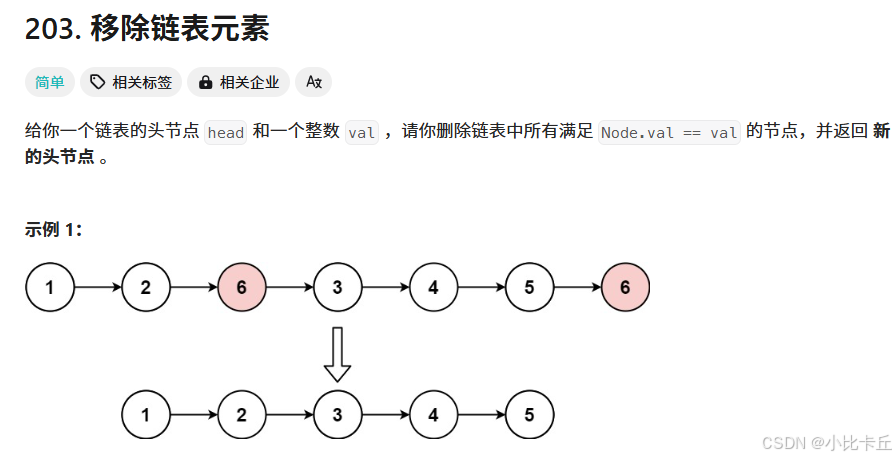
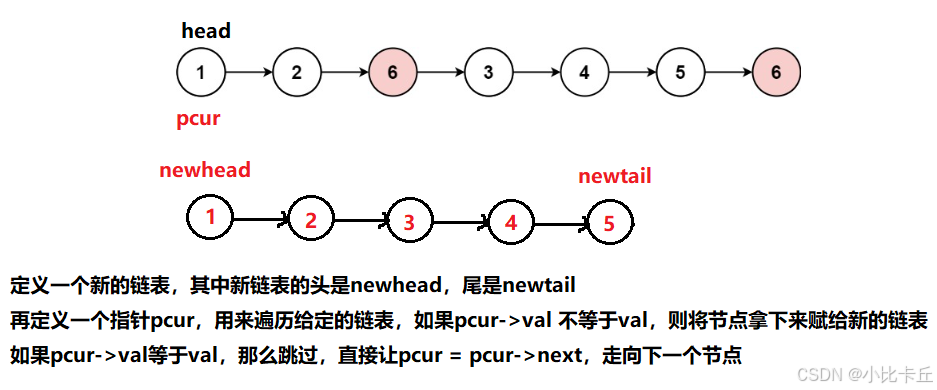
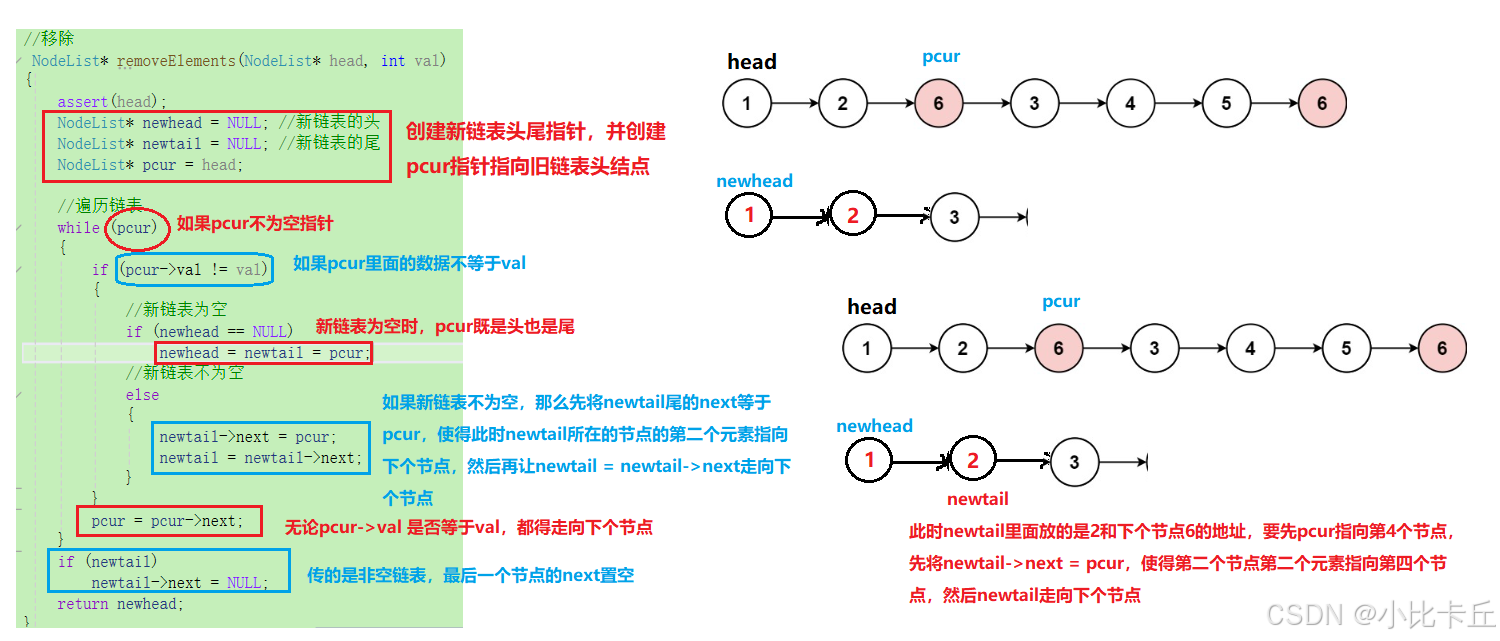
#include <stdio.h>
#include <stdlib.h>
#include <assert.h>
typedef struct ListNode {
int val;
struct ListNode* next;
}NodeList;
NodeList* removeElements(NodeList* head, int val)
{
assert(head);
NodeList* newhead = NULL;
NodeList* newtail = NULL;
NodeList* pcur = head;
while (pcur)
{
if (pcur->val != val)
{
if (newhead == NULL)
newhead = newtail = pcur;
else
{
newtail->next = pcur;
newtail = newtail->next;
}
}
pcur = pcur->next;
}
if (newtail)
newtail->next = NULL;
return newhead;
}
void NodeListPrint(NodeList* phead)
{
assert(phead);
while (phead)
{
printf("%d -> ", phead->val);
phead = phead->next;
}
printf("NULL\n");
}
void test()
{
NodeList* node1 = (NodeList*)malloc(sizeof(NodeList));
NodeList* node2 = (NodeList*)malloc(sizeof(NodeList));
NodeList* node3 = (NodeList*)malloc(sizeof(NodeList));
NodeList* node4 = (NodeList*)malloc(sizeof(NodeList));
NodeList* node5 = (NodeList*)malloc(sizeof(NodeList));
NodeList* node6 = (NodeList*)malloc(sizeof(NodeList));
NodeList* node7 = (NodeList*)malloc(sizeof(NodeList));
if (node1 == NULL || node2 == NULL || node3 == NULL || node4 == NULL || node5 == NULL || node6 == NULL || node7 == NULL)
{
perror("malloc");
exit(1);
}
node1->val = 1;
node2->val = 2;
node3->val = 6;
node4->val = 3;
node5->val = 3;
node6->val = 5;
node7->val = 6;
node1->next = node2;
node2->next = node3;
node3->next = node4;
node4->next = node5;
node5->next = node6;
node6->next = node7;
node7->next = NULL;
printf("移除之前链表为>:");
NodeListPrint(node1);
NodeList* newnode = removeElements(node1, 6);
printf("移除之后链表为>:");
NodeListPrint(newnode);
}
int main()
{
test();
return 0;
}

2. 反转链表
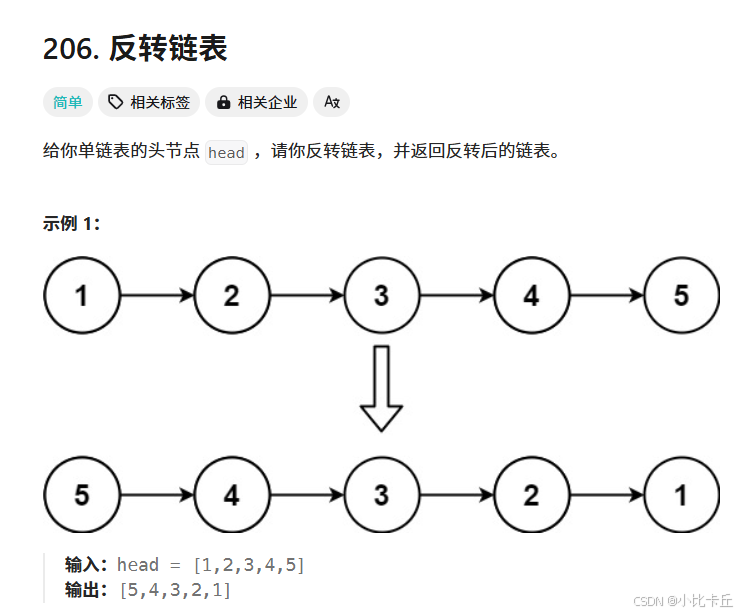
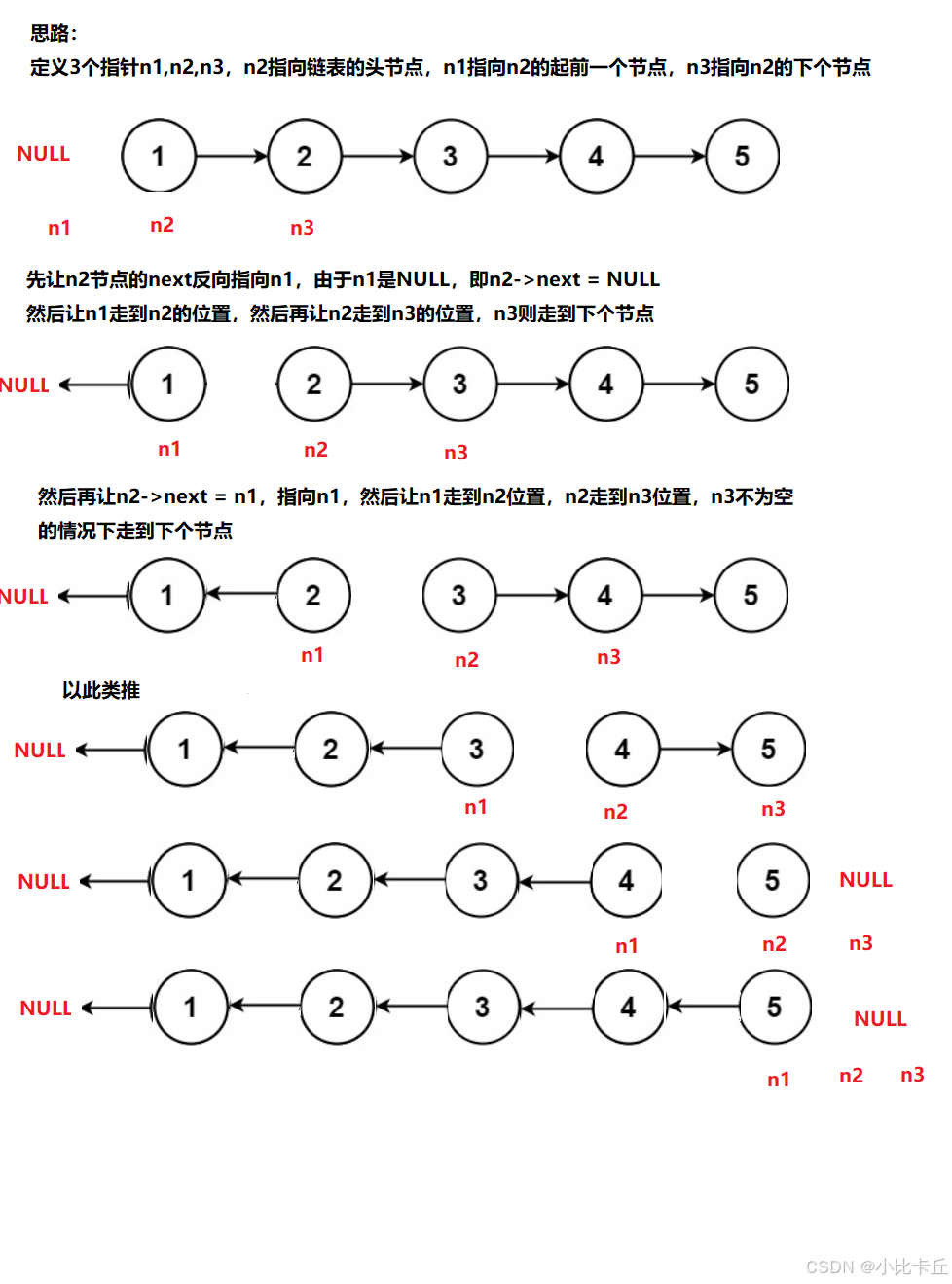
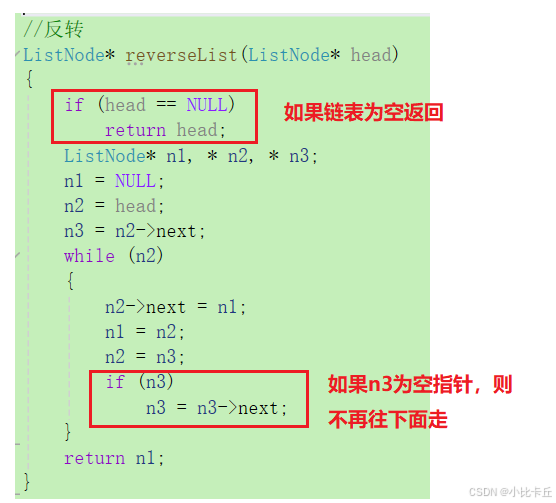
typedef struct ListNode {
int val;
struct ListNode* next;
}ListNode;
ListNode* reverseList(ListNode* head)
{
if (head == NULL)
return head;
ListNode* n1, * n2, * n3;
n1 = NULL;
n2 = head;
n3 = n2->next;
while (n2)
{
n2->next = n1;
n1 = n2;
n2 = n3;
if (n3)
n3 = n3->next;
}
return n1;
}
void ListNodePrint(ListNode* phead)
{
assert(phead);
while (phead)
{
printf("%d -> ", phead->val);
phead = phead->next;
}
printf("NULL\n");
}
void test()
{
ListNode* node1 = (ListNode*)malloc(sizeof(ListNode));
ListNode* node2 = (ListNode*)malloc(sizeof(ListNode));
ListNode* node3 = (ListNode*)malloc(sizeof(ListNode));
ListNode* node4 = (ListNode*)malloc(sizeof(ListNode));
ListNode* node5 = (ListNode*)malloc(sizeof(ListNode));
if (node1 == NULL || node2 == NULL || node3 == NULL || node4 == NULL || node5 == NULL)
{
perror("malloc");
exit(1);
}
node1->val = 1;
node2->val = 2;
node3->val = 3;
node4->val = 4;
node5->val = 5;
node1->next = node2;
node2->next = node3;
node3->next = node4;
node4->next = node5;
node5->next = NULL;
printf("反转链表之前为>:");
ListNodePrint(node1);
ListNode* newnode = reverseList(node1);
printf("反转链表之后为>:");
ListNodePrint(newnode);
}
int main()
{
test();
return 0;
}
3. 找链表中间节点
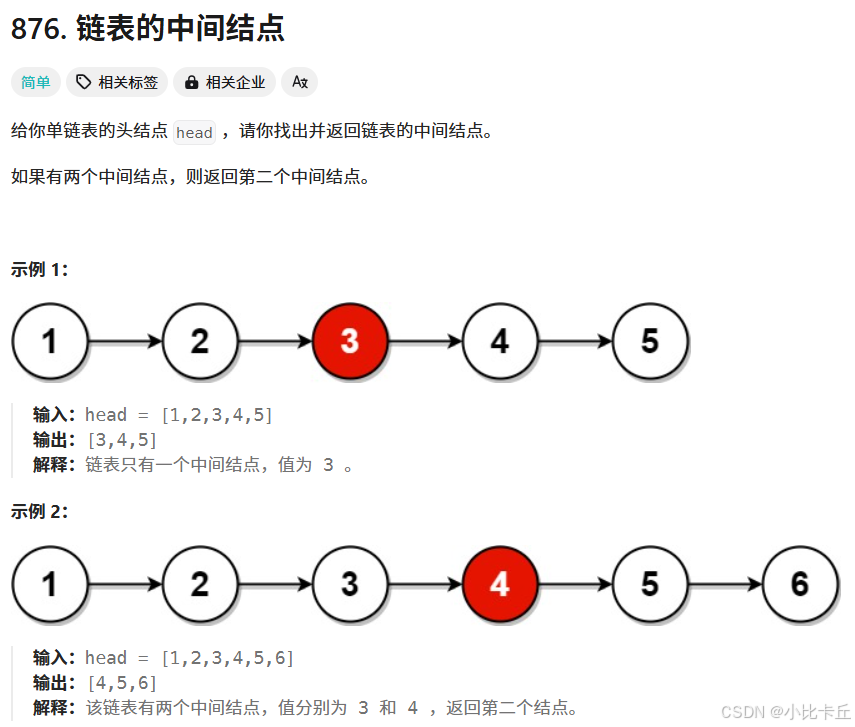
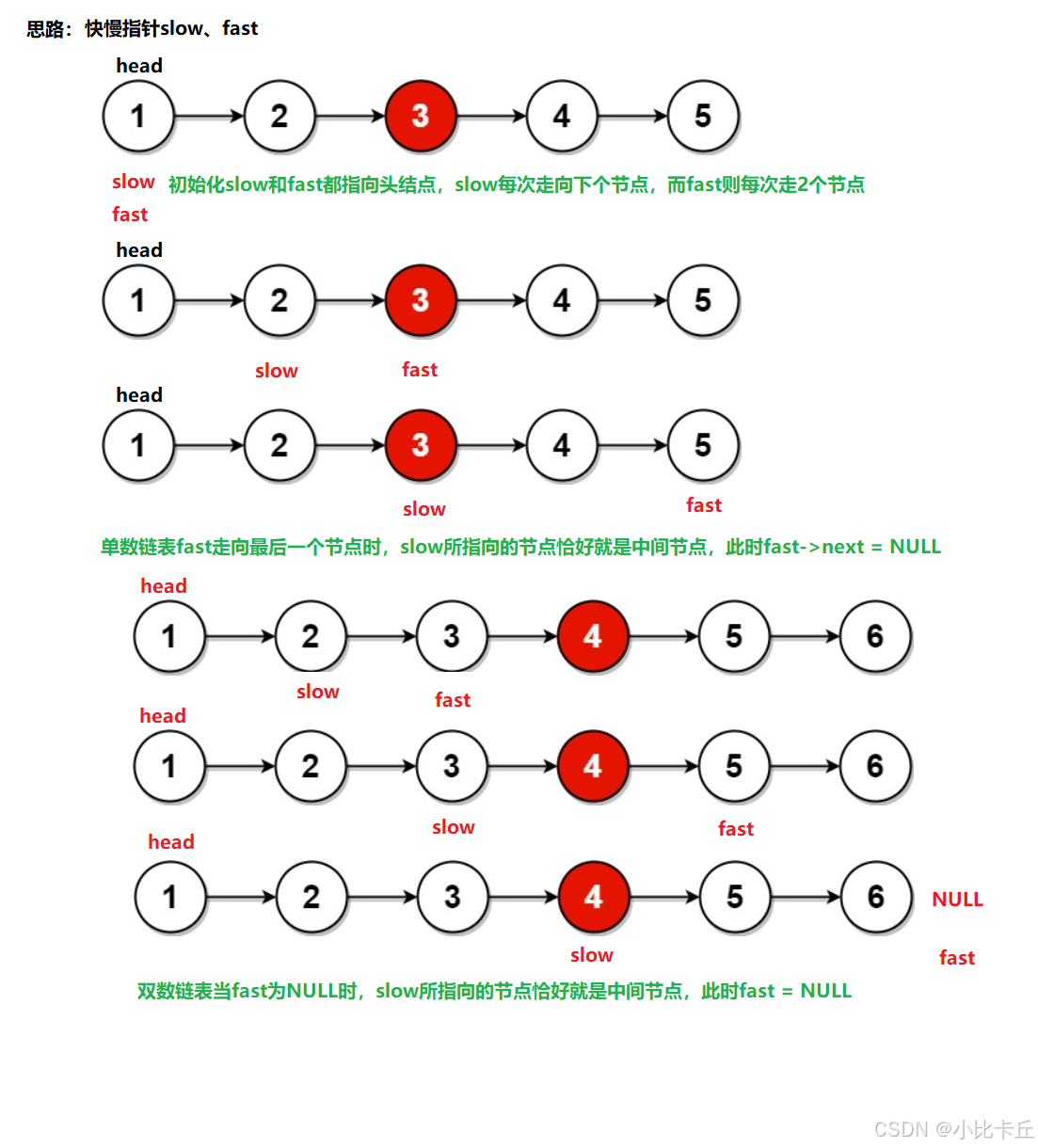
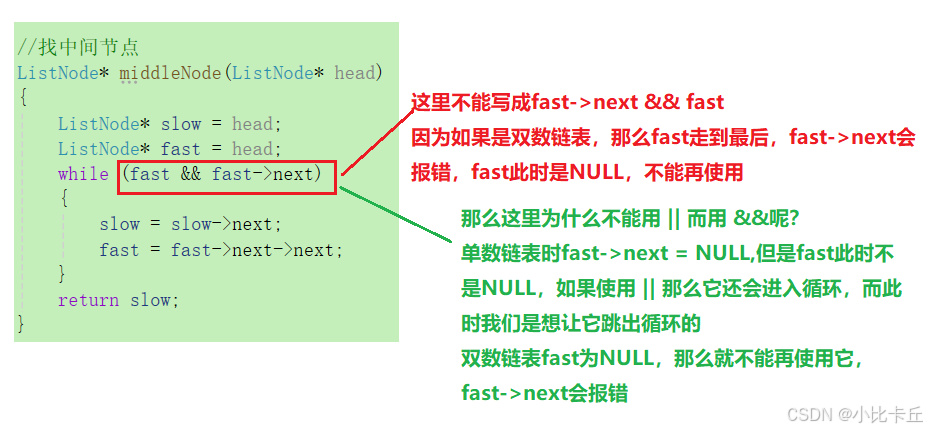
typedef struct ListNode
{
int val;
struct ListNode* next;
}ListNode;
ListNode* middleNode(ListNode* head)
{
ListNode* slow = head;
ListNode* fast = head;
while (fast && fast->next)
{
slow = slow->next;
fast = fast->next->next;
}
return slow;
}
void ListNodePrint(ListNode* phead)
{
assert(phead);
while (phead)
{
printf("%d -> ", phead->val);
phead = phead->next;
}
printf("NULL\n");
}
void test()
{
ListNode* node1 = (ListNode*)malloc(sizeof(ListNode));
ListNode* node2 = (ListNode*)malloc(sizeof(ListNode));
ListNode* node3 = (ListNode*)malloc(sizeof(ListNode));
ListNode* node4 = (ListNode*)malloc(sizeof(ListNode));
ListNode* node5 = (ListNode*)malloc(sizeof(ListNode));
ListNode* node6 = (ListNode*)malloc(sizeof(ListNode));
if (node1 == NULL || node2 == NULL || node3 == NULL || node4 == NULL || node5 == NULL || node6 == NULL)
{
perror("malloc");
exit(1);
}
node1->val = 1;
node2->val = 2;
node3->val = 3;
node4->val = 4;
node5->val = 5;
node6->val = 6;
node1->next = node2;
node2->next = node3;
node3->next = node4;
node4->next = node5;
node5->next = node6;
node6->next = NULL;
printf("链表为>:");
ListNodePrint(node1);
ListNode* newnode = middleNode(node1);
printf("链表中间节点为>: %d\n", newnode->val);
}
int main()
{
test();
return 0;
}
4. 合并两个有序的链表
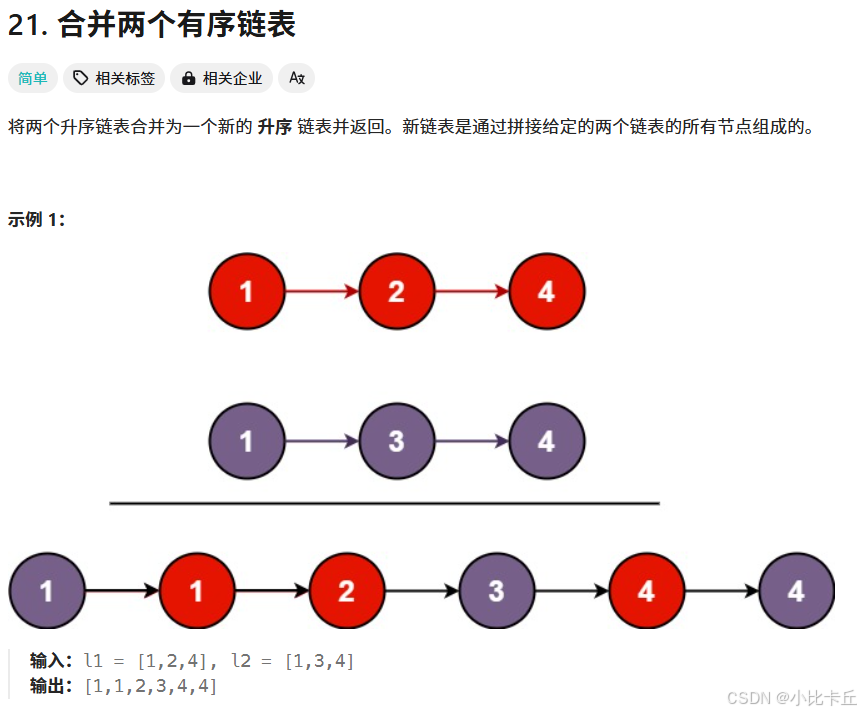
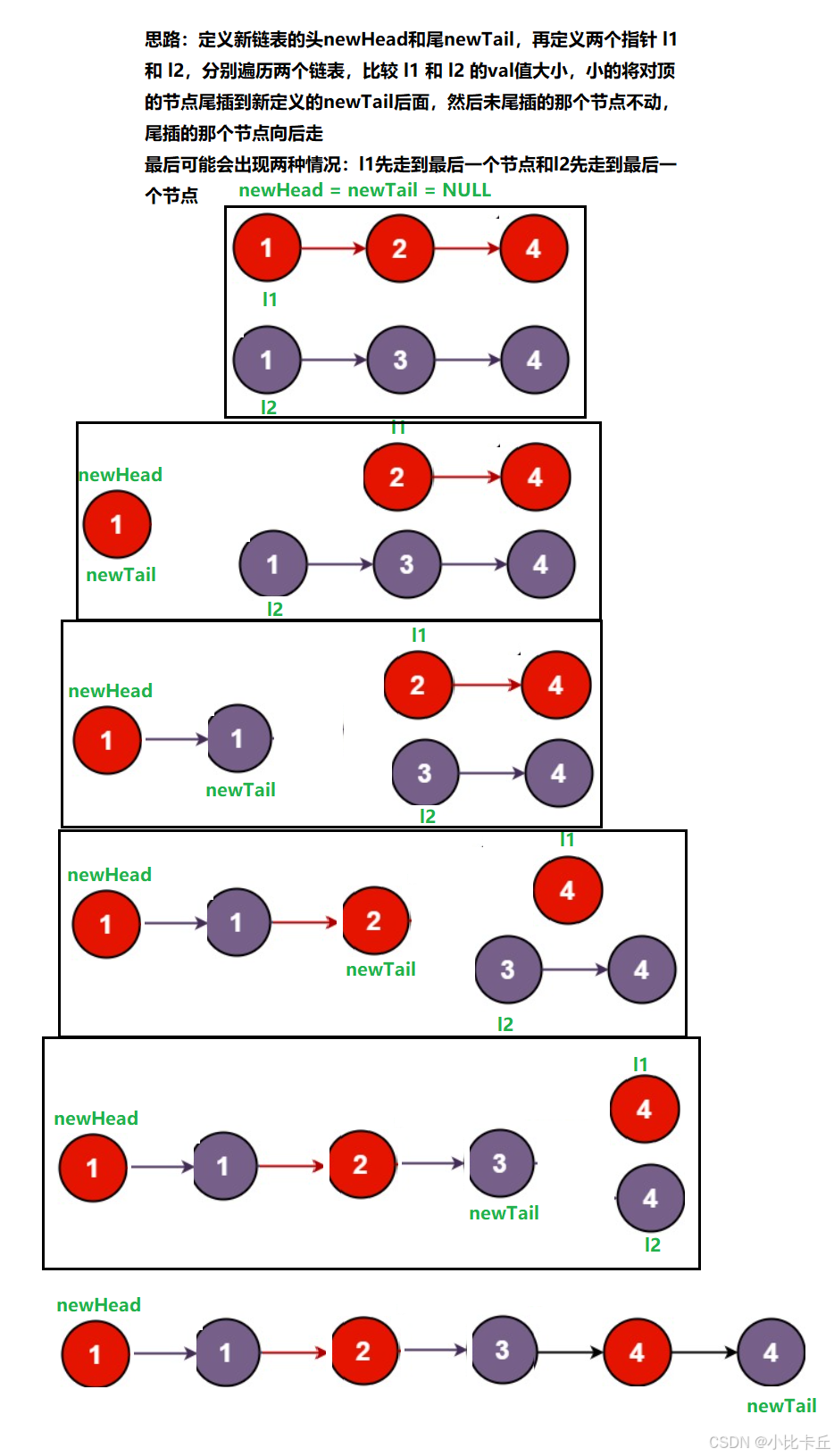
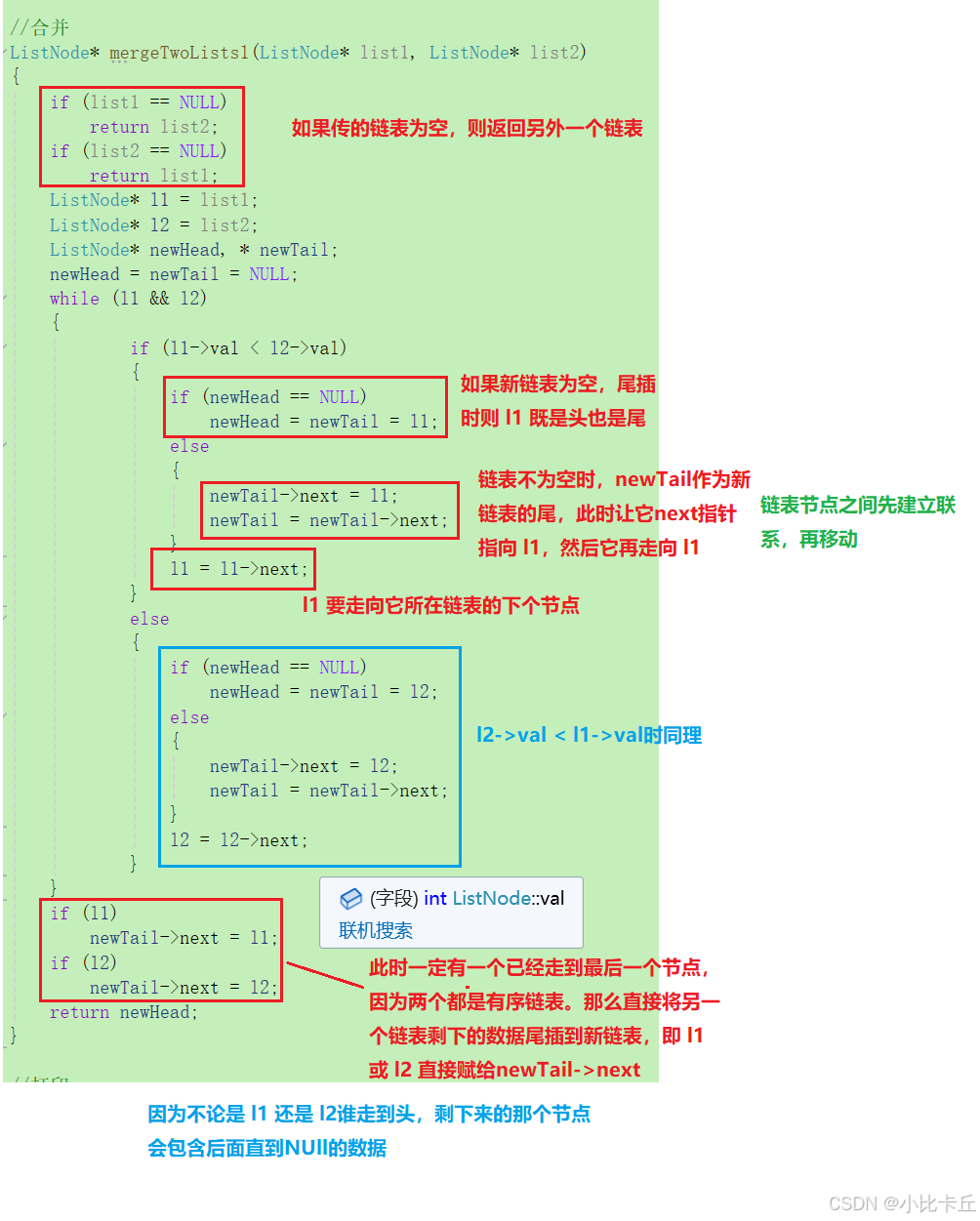
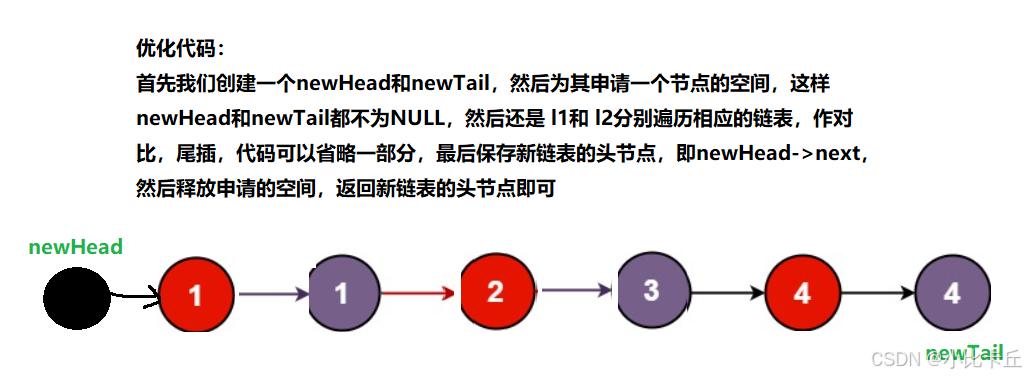
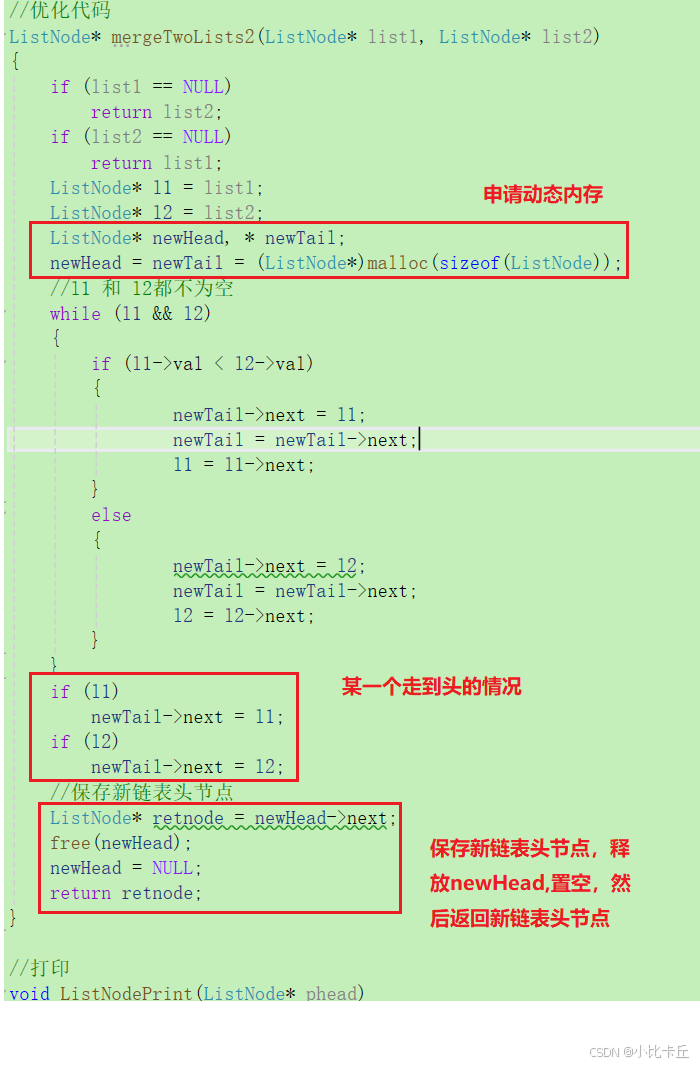
typedef struct ListNode
{
int val;
struct ListNode* next;
}ListNode;
ListNode* mergeTwoLists2(ListNode* list1, ListNode* list2)
{
if (list1 == NULL)
return list2;
if (list2 == NULL)
return list1;
ListNode* l1 = list1;
ListNode* l2 = list2;
ListNode* newHead, * newTail;
newHead = newTail = (ListNode*)malloc(sizeof(ListNode));
while (l1 && l2)
{
if (l1->val < l2->val)
{
newTail->next = l1;
newTail = newTail->next;
l1 = l1->next;
}
else
{
newTail->next = l2;
newTail = newTail->next;
l2 = l2->next;
}
}
if (l1)
newTail->next = l1;
if (l2)
newTail->next = l2;
ListNode* retnode = newHead->next;
free(newHead);
newHead = NULL;
return retnode;
}
void ListNodePrint(ListNode* phead)
{
assert(phead);
while (phead)
{
printf("%d -> ", phead->val);
phead = phead->next;
}
printf("NULL\n");
}
void test()
{
ListNode* node1 = (ListNode*)malloc(sizeof(ListNode));
ListNode* node2 = (ListNode*)malloc(sizeof(ListNode));
ListNode* node3 = (ListNode*)malloc(sizeof(ListNode));
ListNode* node4 = (ListNode*)malloc(sizeof(ListNode));
ListNode* node5 = (ListNode*)malloc(sizeof(ListNode));
ListNode* node6 = (ListNode*)malloc(sizeof(ListNode));
if (node1 == NULL || node2 == NULL || node3 == NULL || node4 == NULL || node5 == NULL || node6 == NULL)
{
perror("malloc");
exit(1);
}
node1->val = 1;
node2->val = 2;
node3->val = 4;
node4->val = 1;
node5->val = 3;
node6->val = 4;
node1->next = node2;
node2->next = node3;
node3->next = NULL;
node4->next = node5;
node5->next = node6;
node6->next = NULL;
printf("合并之前链表1为>:");
ListNodePrint(node1);
printf("合并之前链表2为>:");
ListNodePrint(node4);
ListNode* newnode = mergeTwoLists2(node1, node4);
printf("合并链表之后>:");
ListNodePrint(newnode);
}
int main()
{
test();
return 0;
}
5. 分割链表

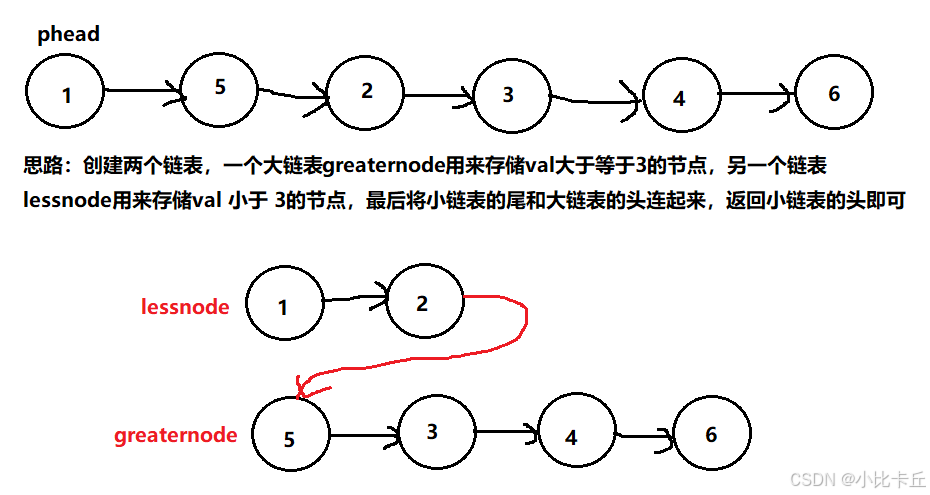
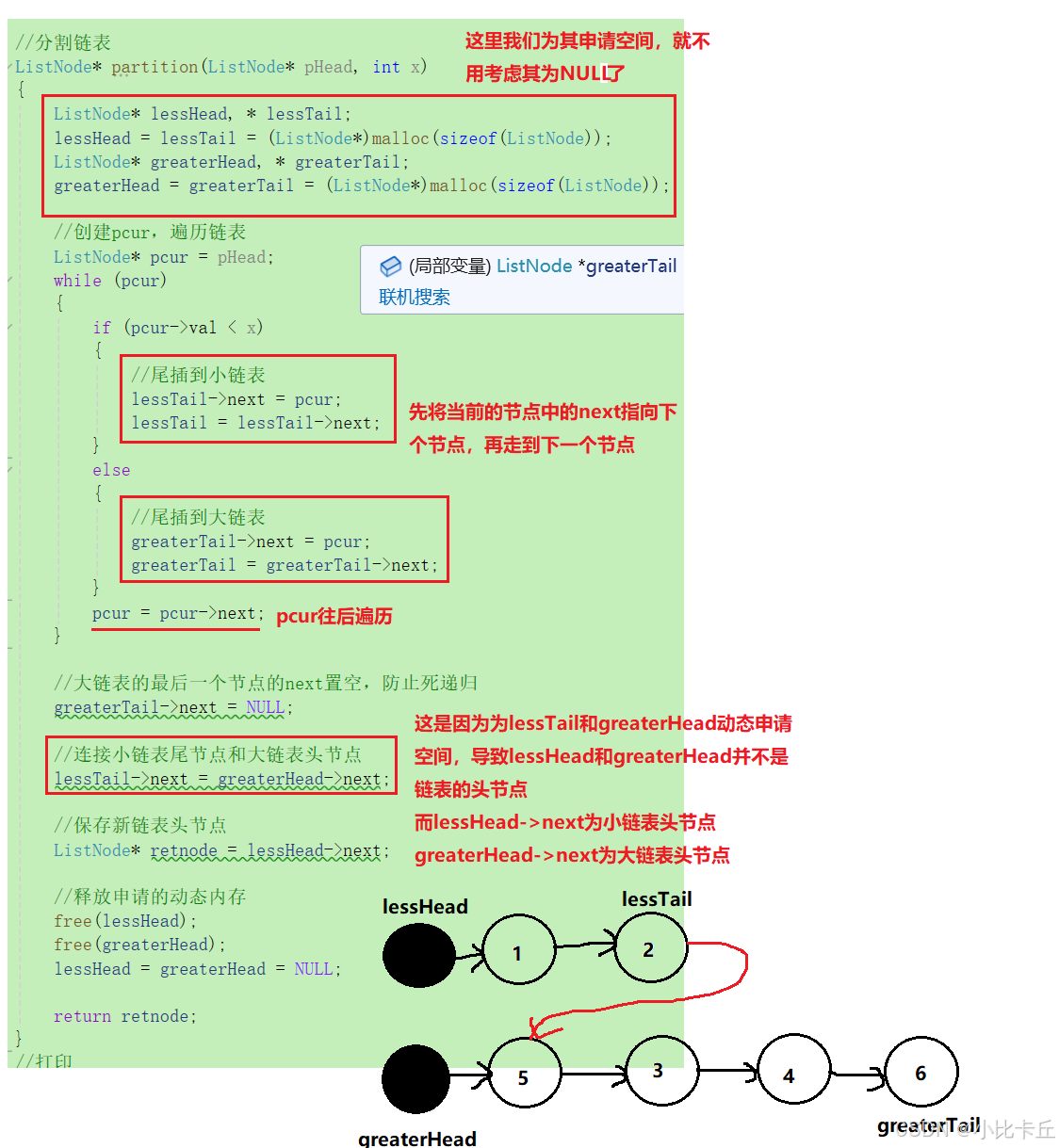
6. 链表的回文结构
- 题目:回文结构,左右对称,例如:1221,12121,12321
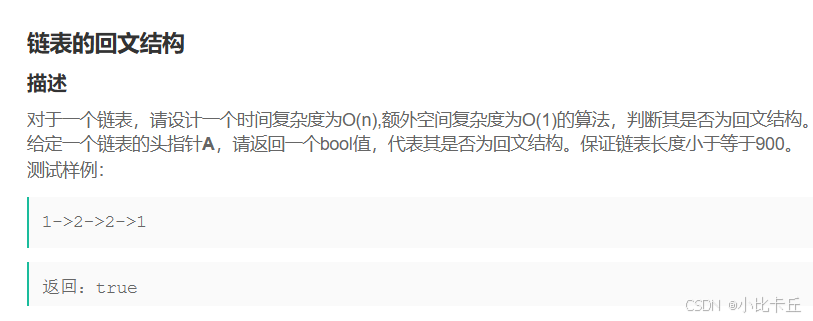
- 思路1:创建新数组,保存链表中所有节点的值,然后再判断数组是否是回文结构即可
#include <stdbool.h>
typedef struct ListNode
{
int val;
struct ListNode* next;
}ListNode;
bool chkPalindrome(ListNode* A)
{
int arr[900] = { 0 };
int i = 0;
ListNode* pcur = A;
while (pcur)
{
arr[i++] = pcur->val;
pcur = pcur->next;
}
int left = 0;
int right = i - 1;
while (left < right)
{
if (arr[left] != arr[right])
return false;
left++;
right--;
}
return true;
}
- 虽然这种方法一定程度帮助我们解题,但该方法受到链表长度的限制,而且严重存在浪费空间
- 思路2:反转链表中间节点之后的一段链表,然后对比前后两段
#include <stdbool.h>
typedef struct ListNode
{
int val;
struct ListNode* next;
}ListNode;
ListNode* middleNode(struct ListNode* head)
{
ListNode* slow = head;
ListNode* fast = head;
while (fast && fast->next)
{
slow = slow->next;
fast = fast->next->next;
}
return slow;
}
ListNode* reverseList(ListNode* head)
{
if (head == NULL)
return head;
ListNode* n1, * n2, * n3;
n1 = NULL;
n2 = head;
n3 = n2->next;
while (n2)
{
n2->next = n1;
n1 = n2;
n2 = n3;
if (n3)
n3 = n3->next;
}
return n1;
}
bool chkPalindrome(ListNode* A)
{
ListNode* mid = middleNode(A);
ListNode* right = reverseList(mid);
ListNode* left = A;
while (right)
{
if (left->val != right->val)
{
return false;
}
left = left->next;
right = right->next;
}
return true;
}
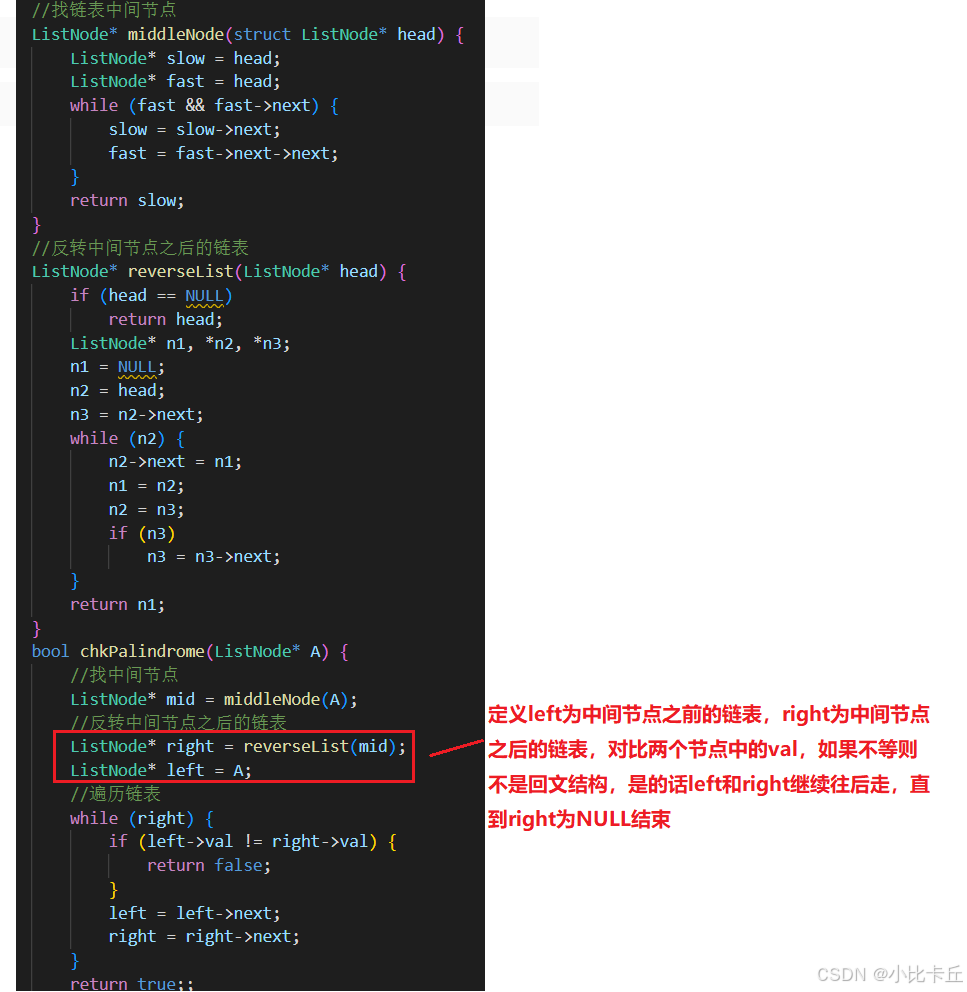
#include <stdbool.h>
typedef struct ListNode
{
int val;
struct ListNode* next;
}ListNode;
ListNode* reverseList(ListNode* head)
{
if (head == NULL)
return head;
ListNode* n1, * n2, * n3;
n1 = NULL; n2 = head; n3 = n2->next;
while (n2)
{
n2->next = n1;
n1 = n2;
n2 = n3;
if (n3)
n3 = n3->next;
}
return n1;
}
bool chkPalindrome(ListNode* A)
{
ListNode* newNode = reverseList(A);
ListNode* pcur = A;
while (pcur)
{
if (pcur->val != newNode->val)
return false;
pcur = pcur->next;
newNode = newNode->next;
}
return true;
}
7. 相交链表
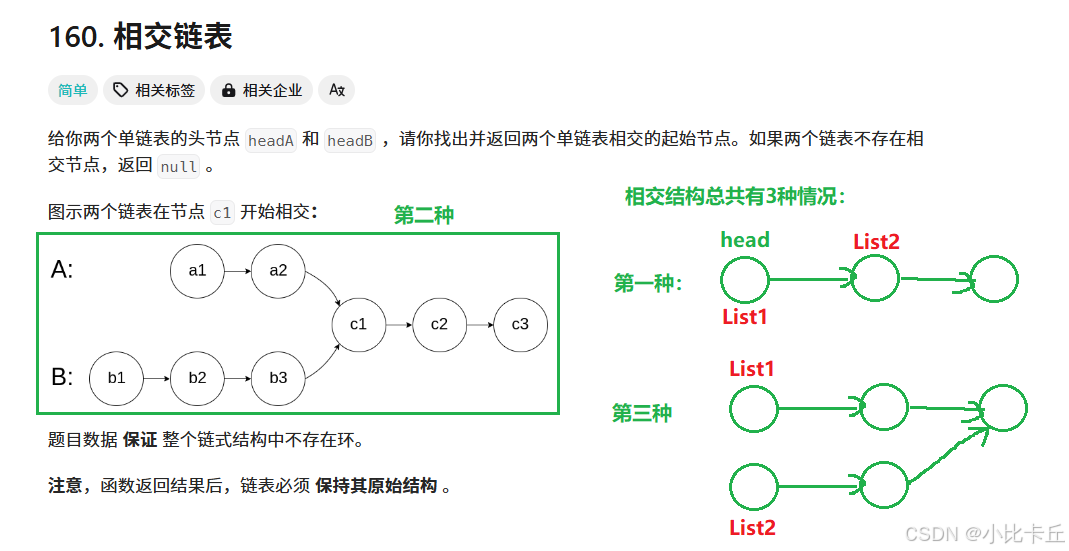
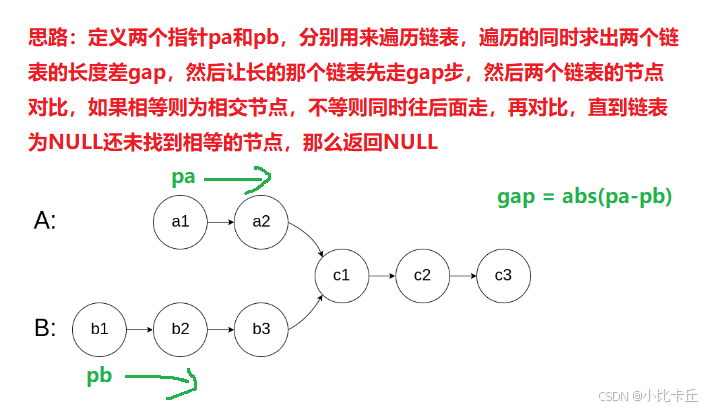
typedef struct ListNode
{
int val;
struct ListNode* next;
}ListNode;
typedef struct ListNode ListNode;
struct ListNode* getIntersectionNode(struct ListNode* headA, struct ListNode* headB)
{
ListNode* pa = headA;
ListNode* pb = headB;
int sizeA = 0, sizeB = 0;
while (pa)
{
pa = pa->next;
sizeA++;
}
while (pb)
{
pb = pb->next;
sizeB++;
}
int gap = abs(sizeA - sizeB);
ListNode* longList = headA;
ListNode* shortList = headB;
if (sizeA < sizeB)
{
longList = headB;
shortList = headA;
}
while (gap--)
{
longList = longList->next;
}
while (shortList)
{
if (shortList == longList)
return shortList;
shortList = shortList->next;
longList = longList->next;
}
return NULL;
}
8. 判断环形链表
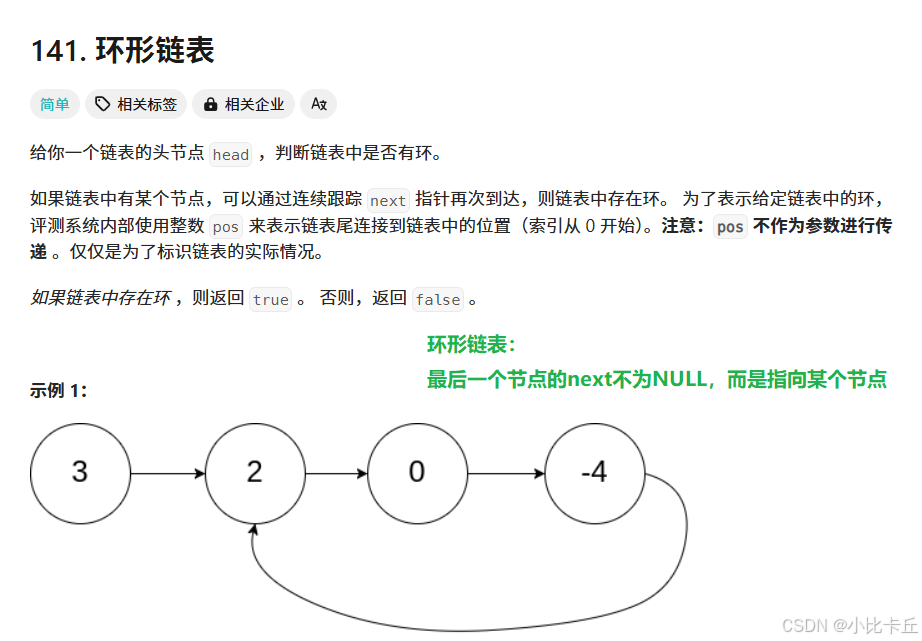

#include <stdbool.h>
typedef struct ListNode ListNode;
typedef struct ListNode
{
int val;
struct ListNode* next;
}ListNode;
bool hasCycle(struct ListNode* head)
{
ListNode* slow = head;
ListNode* fast = head;
while (fast && fast->next)
{
slow = slow->next;
fast = fast->next->next;
if (slow == fast)
return true;
}
return false;
}
- 思考:为什么在环形链表中,快指针走两步,慢指针走一步,两个一定会相遇?
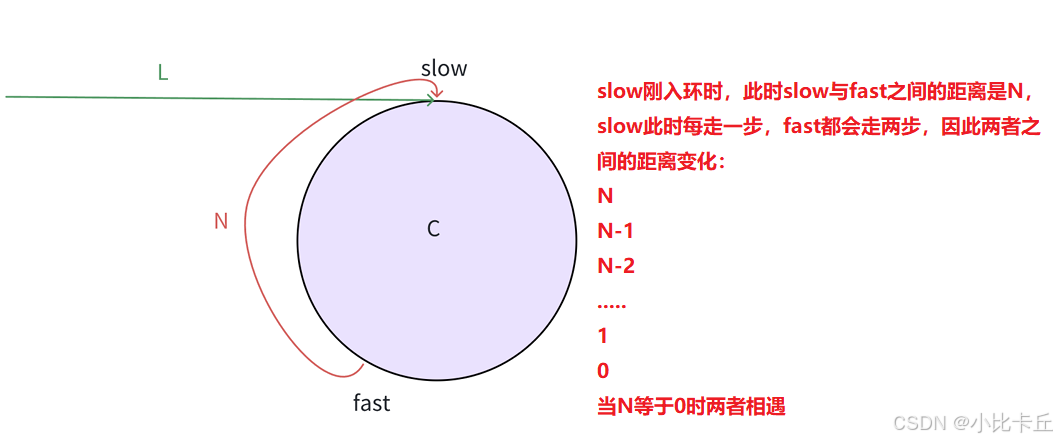
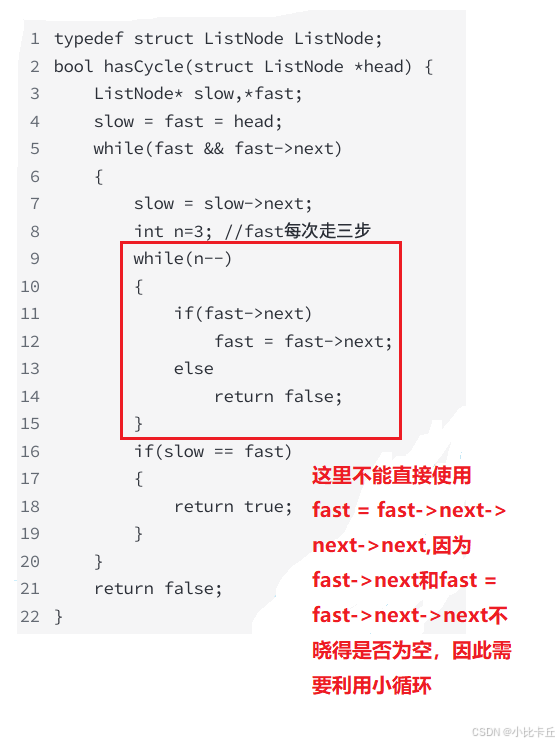
9. 返回环形链表的入环节点
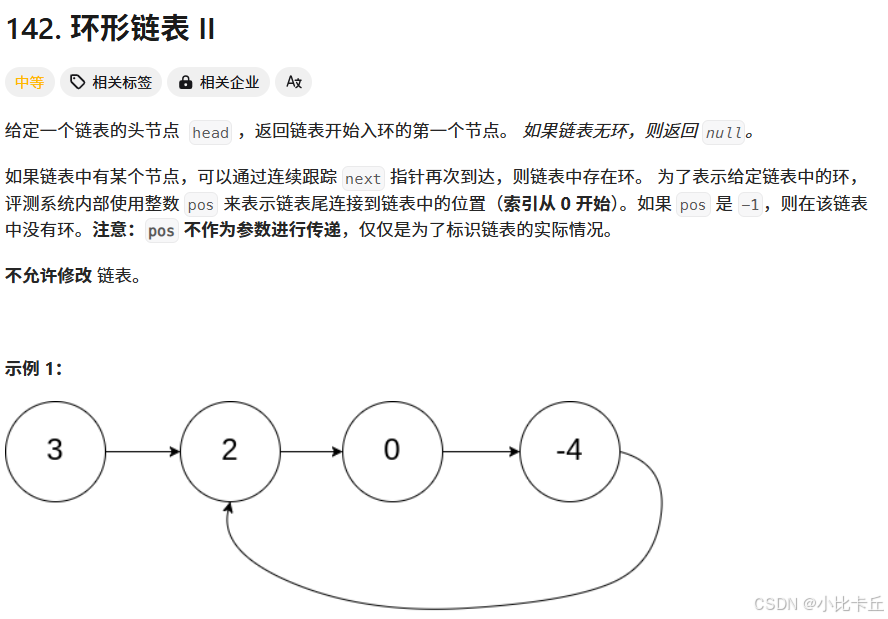
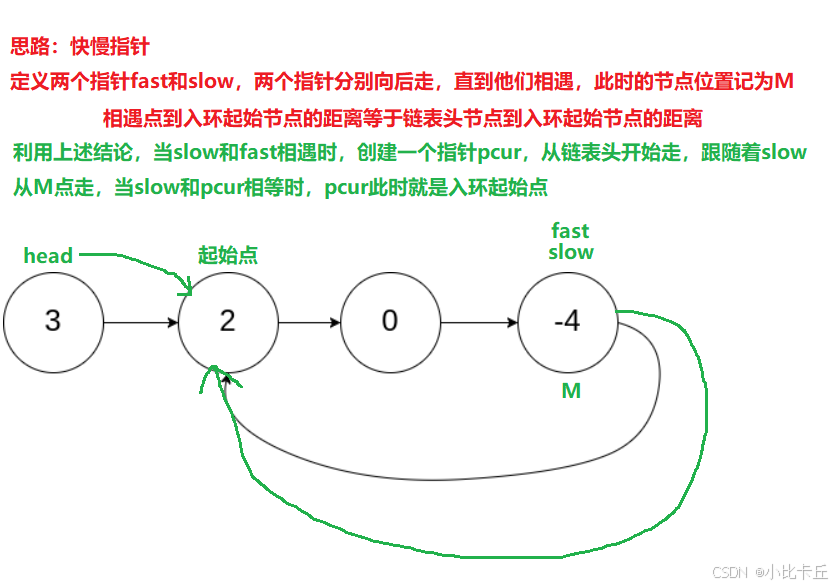
typedef struct ListNode ListNode;
typedef struct ListNode
{
int val;
struct ListNode* next;
}ListNode;
struct ListNode* detectCycle(struct ListNode* head)
{
ListNode* slow = head;
ListNode* fast = head;
while (fast && fast->next)
{
slow = slow->next;
fast = fast->next->next;
if (slow == fast)
{
ListNode* pcur = head;
while (pcur != slow)
{
pcur = pcur->next;
slow = slow->next;
}
return pcur;
}
}
return NULL;
}
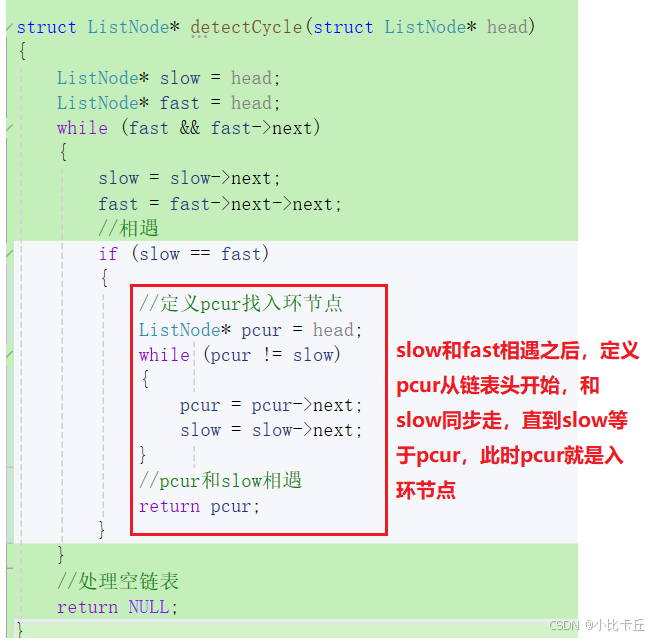
- 证明在带环链表中,相遇点和头节点到入环第一个节点的距离相等
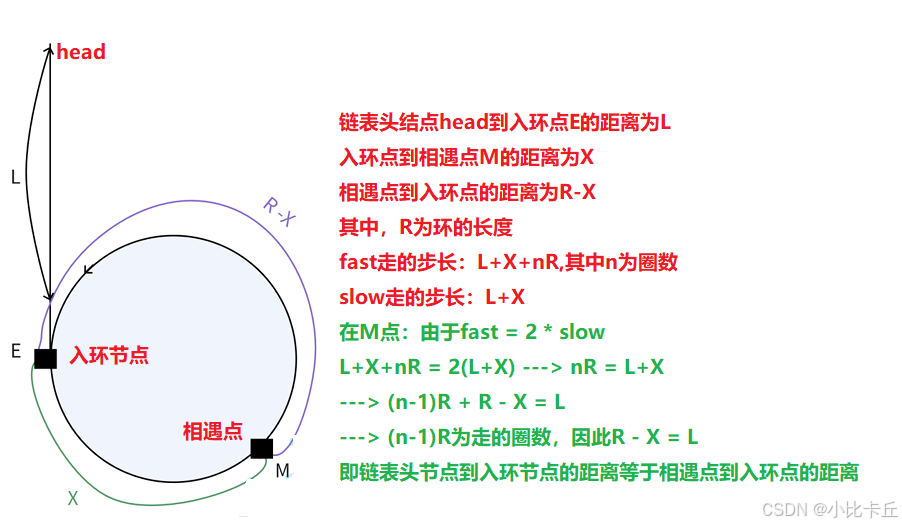
10. 随机链表的复制
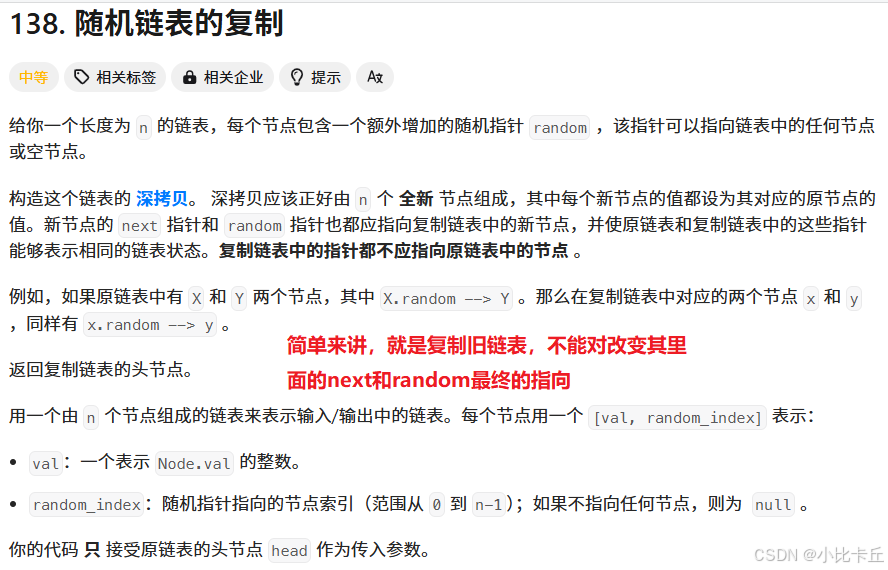
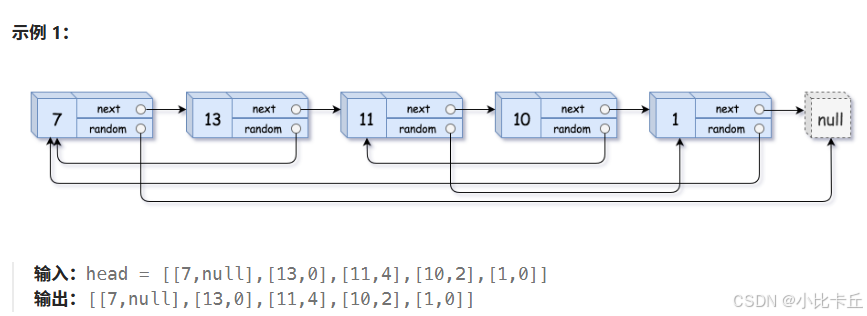
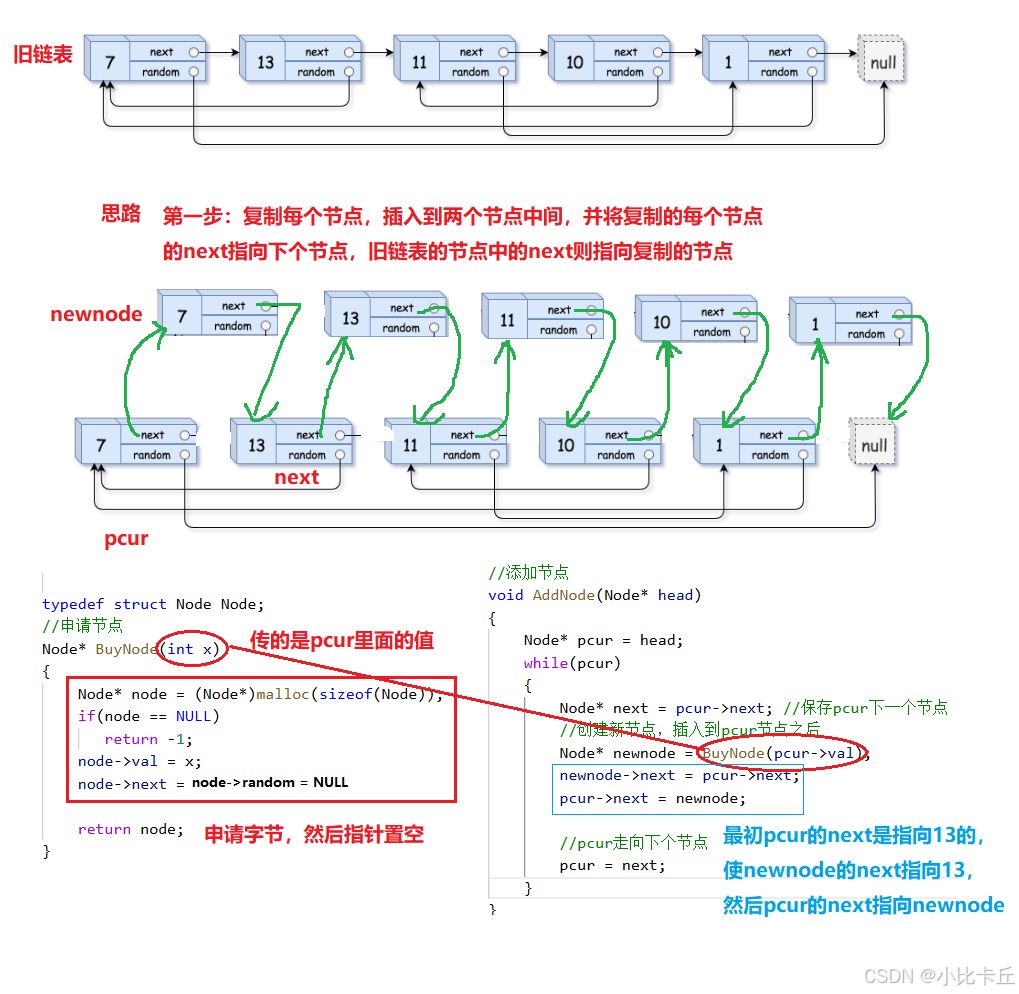
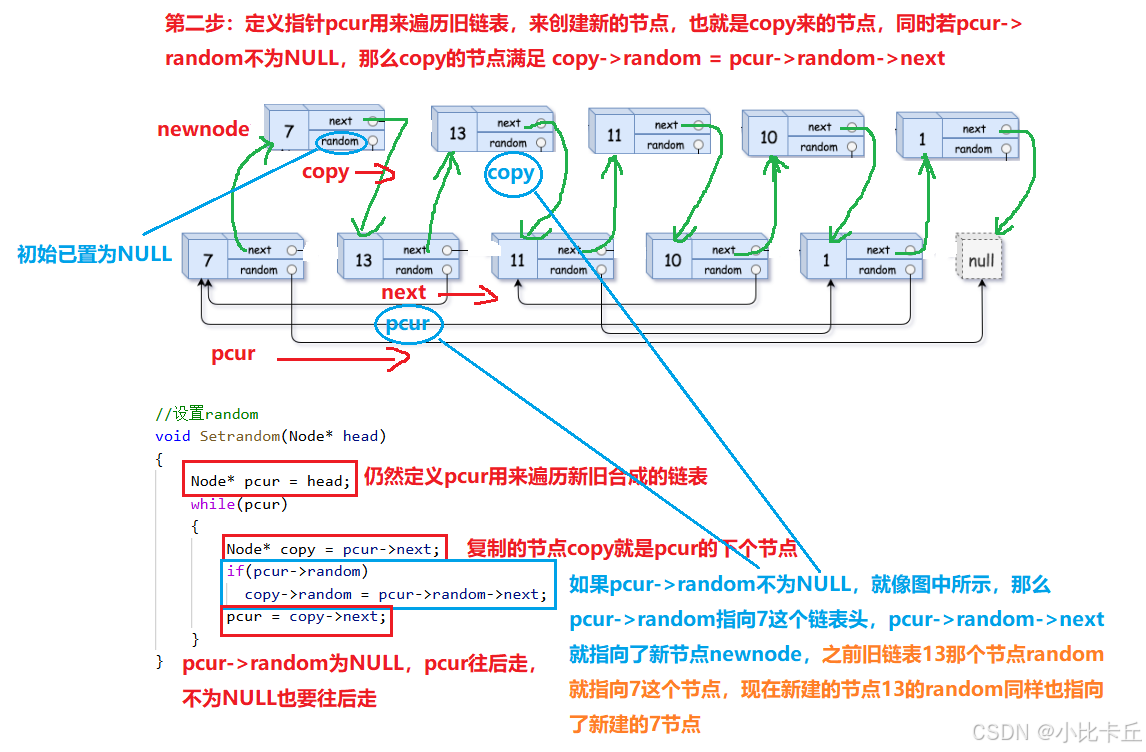
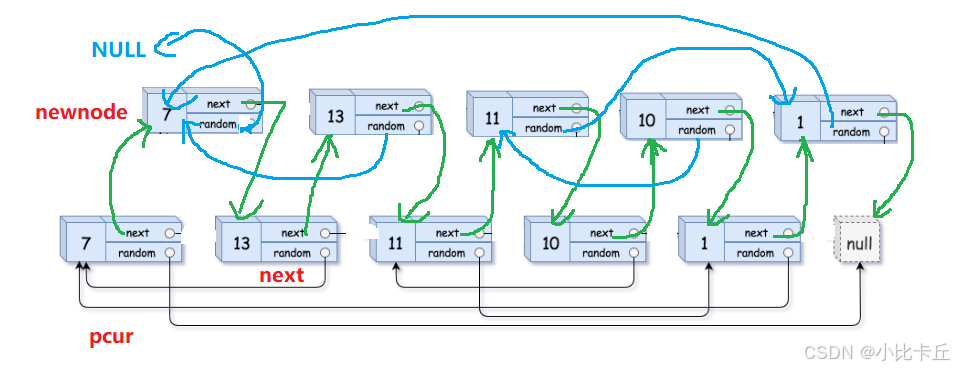
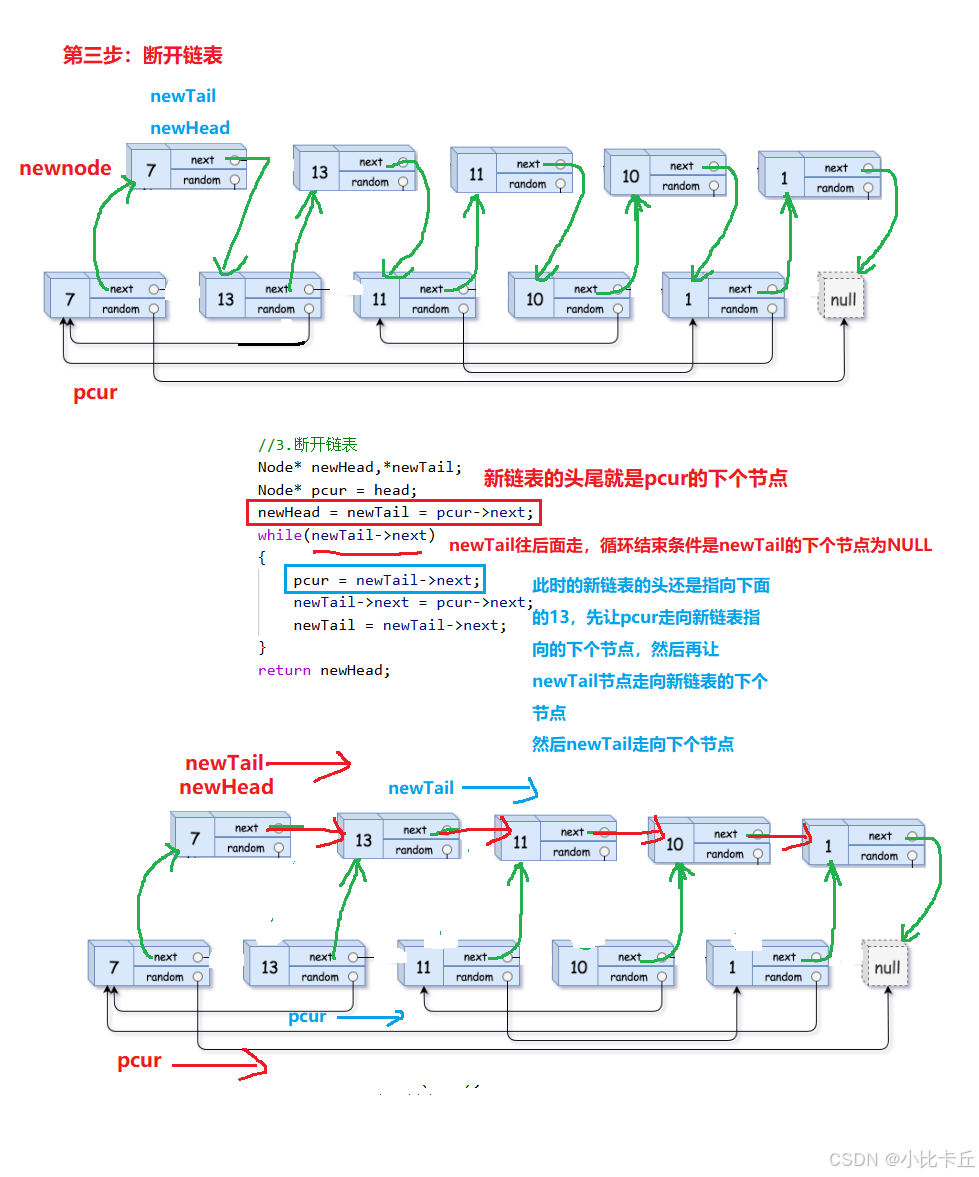
typedef struct Node
{
int val;
struct Node* next;
struct Node* random;
}ListNode;
typedef struct Node Node;
Node* BuyNode(int x)
{
Node* node = (Node*)malloc(sizeof(Node));
if (node == NULL)
return -1;
node->val = x;
node->next = node->random = NULL;
return node;
}
void AddNode(Node* head)
{
Node* pcur = head;
while (pcur)
{
Node* next = pcur->next;
Node* newnode = BuyNode(pcur->val);
newnode->next = next;
pcur->next = newnode;
pcur = next;
}
}
void Setrandom(Node* head)
{
Node* pcur = head;
while (pcur)
{
Node* copy = pcur->next;
if (pcur->random)
copy->random = pcur->random->next;
pcur = copy->next;
}
}
struct Node* copyRandomList(struct Node* head)
{
if (head == NULL)
{
return head;
}
AddNode(head);
Setrandom(head);
Node* newHead, * newTail;
Node* pcur = head;
newHead = newTail = pcur->next;
while (newTail->next)
{
pcur = newTail->next;
newTail->next = pcur->next;
newTail = newTail->next;
}
return newHead;
}



































